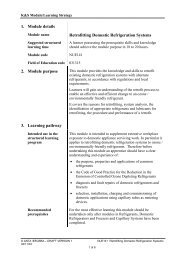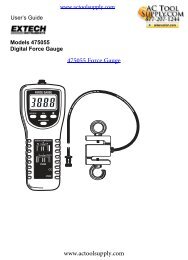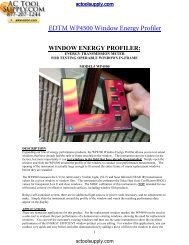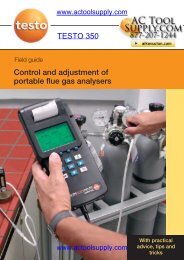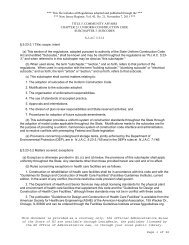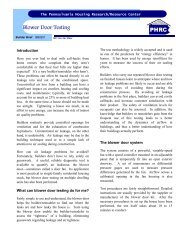Megger DLRO200 Low Resistance Testing - Actoolsupply.com
Megger DLRO200 Low Resistance Testing - Actoolsupply.com
Megger DLRO200 Low Resistance Testing - Actoolsupply.com
- No tags were found...
Create successful ePaper yourself
Turn your PDF publications into a flip-book with our unique Google optimized e-Paper software.
www.actoolsupply.<strong>com</strong>How Does a <strong>Low</strong> <strong>Resistance</strong> Ohmmeter Operate?A low resistance ohmmeter uses two internal measuringcircuits. The supply injects a current into the test samplethrough two leads, usually identified as C1 and C2, and themagnitude of the current is measured. Concurrently, twoprobes (normally referred to as P1 and P2) measure thepotential across the sample. The instrument then performsan internal calculation to determine the resistance of thetest sample.Why does this approach result in a measurement that isindependent of lead resistance and contact resistance?We have represented the <strong>com</strong>plete measurement circuit inFigure 12. Current is injected into the item under test vialeads C1 and C2. The current that flows will be dependentupon the total resistance of this loop and the poweravailable to push the current through that resistance. Sincethis current is measured, and the measured value is used insubsequent calculations, the loop resistance, including thecontact resistance of the C1 and C2 contacts and the leadresistance of C1 and C2, does not have an effect on thefinal result.From Ohm’s Law, if we pass a current through a resistancewe will generate a voltage across the resistance. This voltageis detected by the P1 and P2 probes. The voltmeter to whichthese probes are connected internally has a high impedance,which prevents current flowing in this potential loop. Sinceno current flows, the contact resistance of the P1 and P2contacts produces no voltage and thus has no effect on thepotential difference (voltage) detected by the probes.Furthermore, since no current flows through the P leads theirresistance has no effect.A high current output is one of the qualifying characteristicsof a true low resistance ohmmeter. Generic multimeters donot supply enough current to give a reliable indication of thecurrent-carrying capabilities of joints, welds, bonds and thelike under real operating conditions. At the same time, littlevoltage is required, as measurements are typically being madeat the extreme low end of the resistance spectrum. Only thevoltage drop across the measured resistance is critical, and itis measured at the millivolt level.Good instruments alert the operator of open circuitconditions on the test leads while a few models haveautomatic range selection.Current SelectionDepending on the instrument chosen, the current selectioncan be either manual or automatic. The operator shouldselect the highest current suitable for the test to provide thebest signal to noise ratio for the measurement. Oninstruments that offer current levels in excess of 10 amps,care is required to minimize any heating of the sample thatwould itself cause the resistance of the sample to change.CurrentProbe 1(C1)PotentialProbe 1(P1)Measured <strong>Resistance</strong>Length<strong>Low</strong> <strong>Resistance</strong> OhmmeterConstant CurrentDC SourceMeasuring Circuit(with digital display; R=E/I)DC VoltmeterC1 P1 P2 C2<strong>Resistance</strong>MeasuredPotentialProbe 2(P2)Figure 11: Simplified Example of a 4-Wire MeasurementCurrentProbe 2(C2)Instruments designed for circuit breaker testing have muchhigher current characteristics and the operator must becareful when setting the test current level. Instrumentsdesigned specifically for transformer testing have a specialhigh-voltage power level at the beginning of the test tosaturate the winding. These units then switch to a lowerconstant current mode to measure the winding on thetransformer.Probe and Lead SelectionThe potential and current leads are either connectedseparately or to a probe. When probes are used the potentialconnection is identified with a “P.” The connections areplaced in contact with the sample so that the P-identifiedcontacts or leads are positioned towards each other. Thecurrent contacts are then positioned outside or away fromthe potential connections. This causes the current to flowwith a more uniform current density across the sample beingmeasured.For the more rigorous tests, separate test leads are used andthe current connections are positioned away from thepotential connections by a distance that is 1 1 ⁄2 times thecircumference of the sample being measured. ASTM StandardB193-65 provides guidelines for making a measurement thatwill establish uniform current density. This standard suggestsseparating the current probes from the potential probes by1 1 ⁄2 times the cross sectional perimeter of the test specimen.Figure 13 shows a test being made to the standard on acylindrical test item.The use of probes, Kelvin Clips, or C-clamps will meet mostfield requirements as the operator should be makingrepetitive measurements under the same conditions. Thesharp points on the probes should leave a mark on thespecimen for future testing. In some situations a marker pencan indicate the test area and the probe positions will beidentified by the probe indents.Leads are available in a number of lengths to meet differentfield application requirements. The probe selection is madefrom separate current and potential leads with clips toconnect to the test sample. Helical spring point probes haveboth potential and current probes in the same handle. The“P” identification on the probe identifies the position on thesample at which the measurement is taken. This probearrangement provides a practical method when makingrepetitive measurements (ideal when testing strapconnections in UPS battery supply systems).Kelvin Clips and C-clamps have the current and potentialconnections 180º from each other, providing separate currentand potential connections. The size of the terminalconnection determines which one to select. See Figure 14 forthe different probe/lead configurations.Note: The order of connection of potential and current clips isnot important. However, never connect the potential clip tothe current clip as this will cause an error in the measurementdue to the voltage drop at the current connection interface atthe sample.<strong>Low</strong> Range <strong>Testing</strong>When measuring on the extreme edge of precision andsensitivity, factors be<strong>com</strong>e significant that would be too smallto be of consequence in conventional testing. In lowresistance testing, thermal emfs (electromotive forces) canproduce voltage gradients across the test sample. Althoughonly on the milli-volt level, and of little or no influence on<strong>com</strong>mon multimeter tests, these can cause fluctuations ofseveral digits. Such instability defeats the purpose of a highprecisionmeasurement. In addition, alternating currentinterference can be induced by nearby electric or magneticfields, or may be present from the float charge on standbybattery systems, or through leaky switches, electricalimbalance and so on.C11.5(Cir)P1Circumference (Cir) = 2 Π rZone with UniformCurrent DensityFigure 13: ASTM Standard B193-65P21.5(Cir)C2Figure 12: Basic Operation Diagram10 A GUIDE TO LOW RESISTANCE TESTINGwww.actoolsupply.<strong>com</strong>A GUIDE TO LOW RESISTANCE TESTING 11





